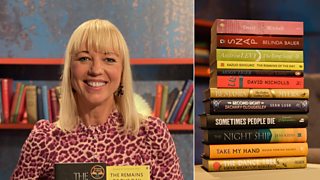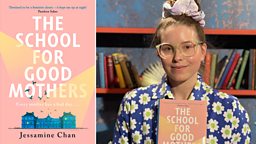From Edwardian etiquette to artificial intelligence: Books chosen by Jessie Cave, Kae Kurd, Ruth Jones and Samuel West
15 November 2022
A novel narrated by a fig tree, a classic Edwardian novel with a house at its centre, and a study of the power of algorithms and AI, all reveal some very human stories. Find out more about the books chosen by this week's guests on Βι¶ΉΤΌΕΔ Two's Between the Covers.

Each week we reveal the favourite books brought in by guests on Between the Covers. This week, Jessie Cave, Kae Kurd, Ruth Jones and Samuel West reveal the Bring Your Own Book titles that inspired them.

Episode two - Favourite books from our guests

Jessie Cave - The School for Good Mothers by Jessamine Chan

The cover says: Frida Liu is a struggling mother. She remembers taking Harriet from her cot and changing her nappy. She remembers giving her a morning bottle. They'd been up since 4am. Frida just had to finish the article in front of her. But she'd left a file on her desk at work. What would happen if she retrieved it and came back in an hour? She was so sure it would be okay.
It's just full of heartbreak on every single page and it's the only book that's ever just stopped me from sleeping.Jessie Cave
Now, the state has decided that Frida is not fit to care for her daughter and she must be re-trained. Soon, mothers everywhere will be re-educated. Will their mistakes cost them everything? The School for Good Mothers is an explosive and thrilling novel about love and the pressures of perfectionism, parenthood and privilege.
Jessie says: “So I read this when I was a few weeks away from giving birth and it was not a good choice; I should not have done that.
It's so brilliant and haunting, and just ahead of its time. It's about a mother who one day makes a terrible decision. She's tired, she’s stressed, she's busy, like all mothers, and she decides to go and pick something up from her office, which is half an hour away. She puts her 18-month-old little girl in a baby bouncer and thinks that she'll be okay. She makes that decision and she obviously risks now losing her child because the neighbour finds out.
It’s a story of how Frida has to basically be taught to be a mother in order to get her child back. She is sent to a school for good mothers, with a load of other mums who've made one bad decision, and they can range from a little thing to a... right okay, that was a terrible decision. You shouldn't have done that.
It’s basically a prison and they're all given these robots and they have to prove via tests that they’re a good mother, and that they haven't let their child die, or get angry. Any upset they’re kind of docked points on, and you don't know whether Frida is eventually going to get her daughter back.
I's just full of heartbreak on every single page and it's the only book that's ever just stopped me from sleeping.”

Kae Kurd - Scary Smart by Mo Gawdat

The cover says: Artificial intelligence is smarter than humans. It can process information at lightning speed and remain focused on specific tasks without distraction. AI can see into the future, predicting outcomes and even use sensors to see around physical and virtual corners. So why does AI frequently get it so wrong? The answer is us. Humans design the algorithms that define the way that AI works, and the processed information reflects an imperfect world. Does that mean we are doomed?
Essentially the only way to tackle AI is by being more human.Kae Kurd
In Scary Smart, Mo Gawdat, the internationally bestselling author, draws on his considerable expertise to answer this question and to show what we can all do now to teach ourselves and our machines how to live better.
Kae says: “I feel like this book really woke me up to the nature of AI and the imminent threat that is facing us, and how we're giving birth to a technology that is going to look at us like we view chimps. And that sort of frightened me.
[Mo Gawdat] used to work for Google X, which are a branch of inventions and stuff. He's a very smart man. He talks about the AI that we create, for example, that we need to counter with more AI that's a lot more compassionate and a lot more empathetic. A lot of the AI that's being created now is based off of greed, like things in a stock market. So you programme an AI to buy you stocks and sell you stocks; its primary focus is profit, so it doesn't care about the human cost or the environmental costs, and it just does what it's programmed to do.
This book definitely wasn't a way to unwind. This was more of a wake up call. But, he does provide optimism at the end about the way to tackle it. And the only way is by being more human, and by tapping into all the positive things about humanity. So love, empathy. I think everybody should read it in order to be more knowledgeable on the subject.

Ruth Jones - The Island of Missing Trees by Elif Shafak

The cover says: It is 1974 on the island of Cyprus. Two teenagers, from opposite sides of a divided land, meet at a tavern in the city they both call home. The tavern is the only place that Kostas, who is Greek and Christian, and Defne, who is Turkish and Muslim, can meet, in secret, hidden beneath the blackened beams from which hang garlands of garlic, chilli peppers and wild herbs.
The fig tree is the narrator. Now, I know that might sound a bit weird but it is absolutely incredible.Ruth Jones
This is where one can find the best food in town, the best music, the best wine. But there is something else to the place: it makes one forget, even if for just a few hours, the world outside and its immoderate sorrows. In The Island of Missing Trees, prizewinning author Elif Shafak brings us a rich, magical tale of belonging and identity, love and trauma, nature, and, finally, renewal.
Ruth says: “You should be utterly, utterly excited. I tell everybody to read this. It's the most beautiful story.
I was given it. It wasn't a book I would have chosen to read necessarily. It's essentially a love story of forbidden lovers. You know, the old Romeo and Juliet thing. Set in Cyprus in 1974, just before the Civil War. It is a love story about two sixteen-year-olds, he’s a Greek Cypriot, she’s a Turkish Cypriot, so they’re both different. Christian vs. Muslim. And they secretly meet at this cafe called The Happy Fig, which has this beautiful fig tree growing through the middle of it.
The story spans about five decades. It is utterly beautiful, and you think initially 'oh it’s just a love story' and it’s so much more than that, because the fig tree is the narrator. Now, I know that might sound a bit weird but it is absolutely incredible. The metaphors that are used in the whole story are just so beautiful and the way that she uses nature.
It really is an incredibly moving story and it’s got the best twist at the end that I just didn’t see coming. I defy anyone not to be in tears at the end of it so I thoroughly recommend it. I tell everybody to read it.”

Samuel West - Howards End by E. M. Forster

The cover says: 'Only connect' is the idea at the heart of this book, a heartbreaking and provocative tale of three families at the beginning of the twentieth century: the rich Wilcoxes, the gentle, idealistic Schlegels and the lower-middle class Basts. As the Schlegel sisters try desperately to help the Basts and educate the close-minded Wilcoxes, the families are drawn together in love, lies and death. Frequently cited as E. M. Forster's finest work, Howards End brilliantly explores class warfare, conflict and the English character.
I ended up studying English at university because of this book.Samuel West
Samuel says: “This is a book from 1910 and generally thought to be Forster’s best novel. It’s set in late-Edwardian England. It’s about three families. The Schlegels, who the tabloids nowadays would call metropolitan liberal elite. They're intellectual, into art, music, feminism. The Wilcoxes, who are a capitalist family who make their money in the colonies. We're never quite sure how. And the Basts. Leonard Bast who is a young, lower middle class bank clerk, intent on improving himself, and his partner who he’s promised to marry - Jackie, who's older than him, in her 30s, who is what used to be described as, in inverted commas, ‘an actress’.
I was given this by a very important teacher when I was sixteen, and as a lefty teen it knocked me sideways. I did science A-levels and I actually gave up chemistry and ended up studying English at university because of this book. And then a few years after leaving university, I met James Ivory for the Merchant Ivory adaptation of this book.
And I went in and read for Leonard, the lower middle class clerk, and I got it, and the film turned out to be amazing. It won three Oscars, and it's thirty years old now but it's really lasted, but I always hope that it will drive people back to the book because the book is so good.
I should say one thing about the title character, who is a house, without an apostrophe, so it's not about the death or the bottom of somebody called Howard. It's a house and it belongs to Mrs. Wilcox, who is the matriarch of the capitalist family, but she doesn't really fall into the money or the art camp. She kind of grows out of the ground, like the house does. The destiny of the house, the way it goes at the end and who inherits it is quietly revolutionary for 1910 I think.”

Celebrity confessions: Reading comfort zones

Reading comfort zones
Sara discovers the books that Samuel West, Kae Kurd, and Jessie Cave usually reach for.

More Books from Βι¶ΉΤΌΕΔ Arts
-
![]()
Shelf care: 16 books to banish the winter blues
See more of this winter's recommendations from Between the Covers.
-
![]()
imagine... 2022: Malorie Blackman: What If?
Former Children's Laureate Malorie Blackman discusses the key moments in her life that made her a writer.
-
![]()
Inside Culture
Mary Beard interviews Booker-nominated British-Turkish novelist Elif Shafak.
-
![]()
Turn Up for the Books
Literature and library chat with Irenosen Okojie, Simon Savidge and Dan Smith










